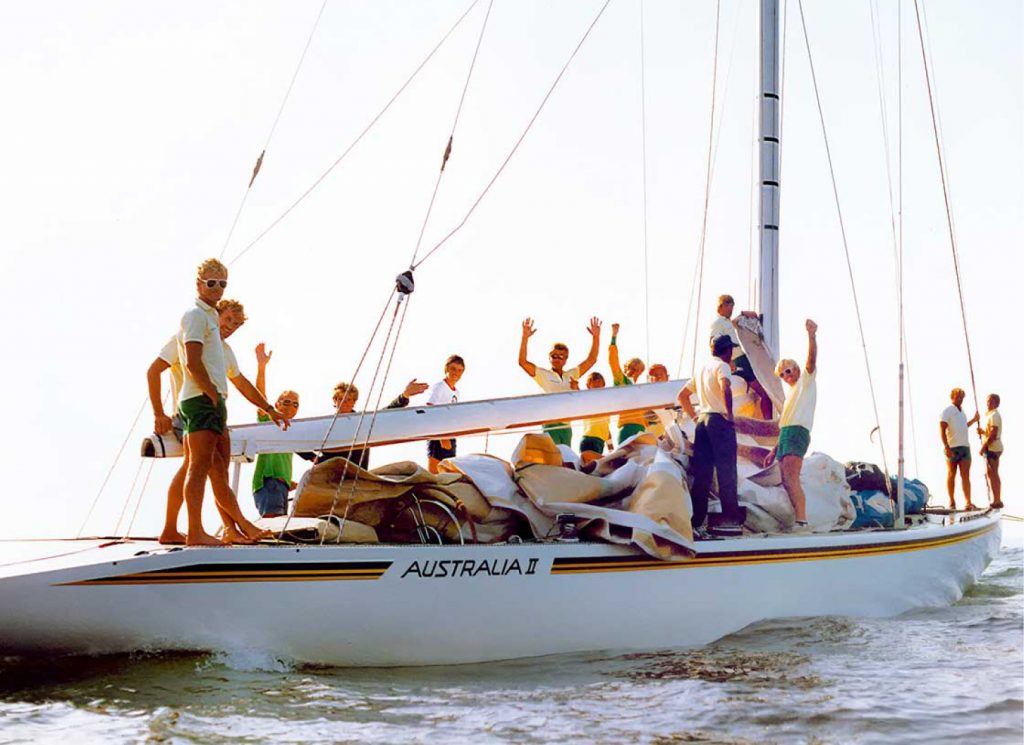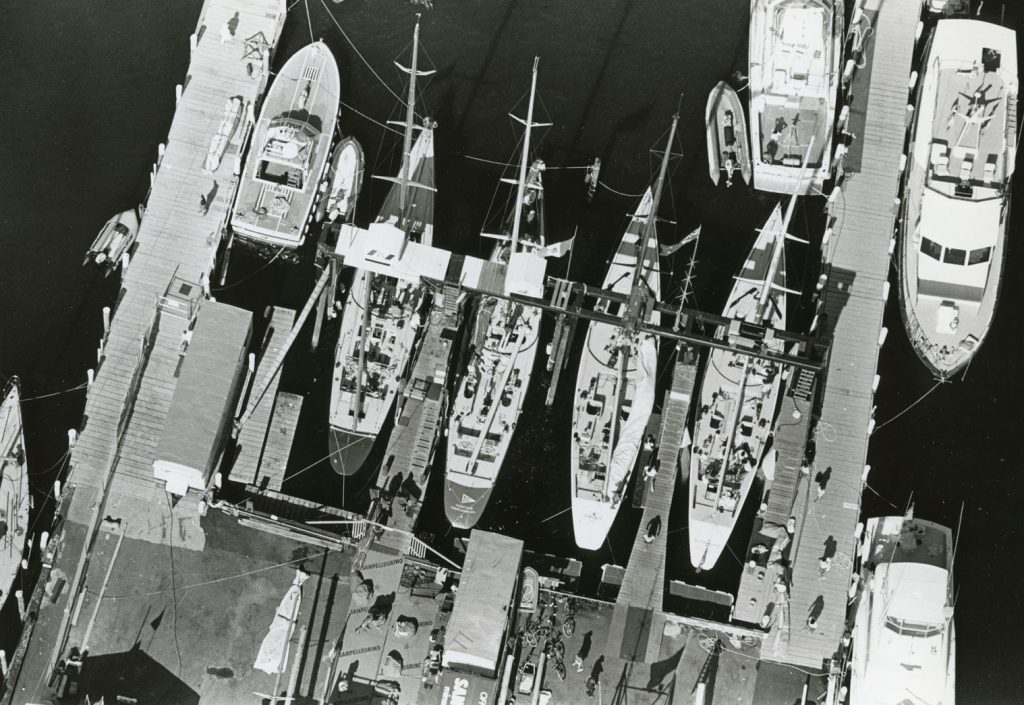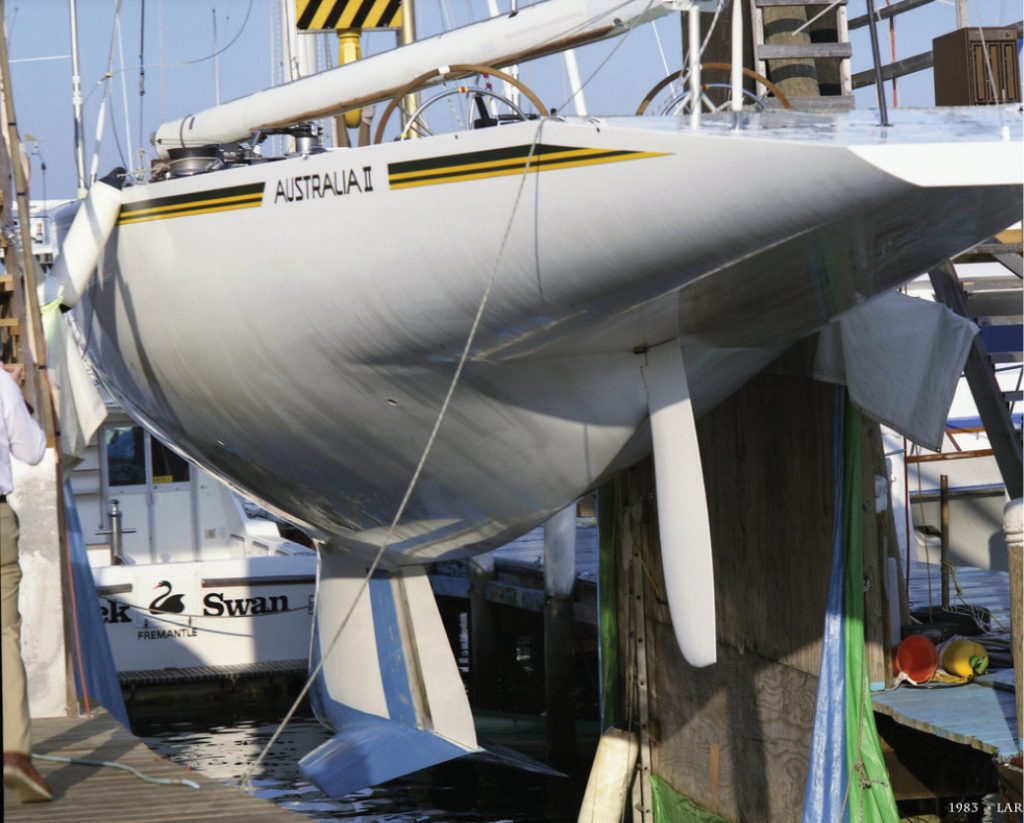By Brian Stinson
This September 26 marks the 40th anniversary of Newport losing the cup – the America’s Cup. I was born in Providence but raised in Newport, Rhode Island – the sailing capital of the world and beyond – and feel extremely privileged to have witnessed many incredible, outrageous, comical, over-the-top moments and spontaneous events.

Having broken the longest winning streak in sporting history, the crew of Australia II celebrates. © Larry Moran
The summer of 1983 was not my favorite, but events of that momentous day produced the most incredible spectacle I’ve ever seen here. It was one of the best nights of my life. I’d spent previous summers working as an ocean lifeguard at First Beach for the Newport Recreation Department, but coming home from school in May I had a strange feeling something spectacular was going to happen. This was a “Cup summer,” a Newporters’ term for the yacht races and attendant pageantry around town every three or four years. I grew up on upper Ayrault Street, and as a kid the Goodyear Blimp cruising overhead, lit up with scrolling messages, was a cool thing to watch in the nighttime sky.
I took a parking lot job downtown, at the first timeshare hotel to be built in Newport. Located on Thames Street, Inn on the Harbor opened right before the summer season adjacent to Williams and Manchester Shipyard, where some of the 12 Metres were kept, most notably Australia II. The hotel’s rooftop deck offered an incredible view of the harbor and Narragansett Bay and directly below, the Cup syndicate compounds to the left and Christie’s Restaurant on the right. All of my summers had been a blast, but I didn’t know how this one would play…though I knew I’d given up a good paying job for a low paying one.

From left to right in the Challenger paddock are France 3, Azzurra, Challenge 12, and Australia II. Brian Stinson Collection
As Defender and Challenger Trials progressed you could feel momentum building daily, right up to the Cup Finals. A quick recap: The American Defenders had won three races to the Australians’ one and were looking to take it all by winning a fourth, but the Aussies rallied to tie the series at 3-3 and a deciding seventh race was needed. The American boat Liberty, skippered by Dennis Conner, led that final race for four of the six legs before being overtaken.
This was long before the days of multiple cable TV sports channels. Eastern Sports Network (now ESPN) was only two years old, and Aquidneck Island had not been wired so we didn’t have cable service. Our local Channel 10 televised Race 7, a single camera capturing the action from a helicopter.
The Australians had won, but hours would elapse before their arrival in town because the races were held so far from shore. As I was exiting the hotel lobby with my girlfriend I ran into Joe Griffiths, Sr., who owned the management contract for the facility at that time. With people flowing into the wharf area and hotel, he threw me a walkie-talkie and ordered me, although I was not on the clock, to immediately go to the rooftop and secure it from becoming overcrowded with not only guests, but whoever realized this was the only true vantage point in town for what was about to unfold.
It was a picture perfect late afternoon. As the sun started to set over the calm waters of the bay the sky turned red and the Twelves appeared, rounding Fort Adams and entering the harbor. Darkness was settling in and you could see buoys with their lights blinking red and green. It was then that Australia II came into view, huge green battle flag emblazoned with the team’s trademark boxing kangaroo mascot with red gloves, colors matching the reflected buoys.
Slowly rounding Goat Island accompanied by a massive flotilla and a cacaphony of blasting air horns, Australia II began a clockwise victory lap of Newport Harbor. The boys took their time passing Newport Yacht Club, basking in glory en route to their berth directly in front of me. All along the wharves – and I mean every inch – people clamored for a glimpse, cheering the winners despite them not being the home team.
The people. The crowds. The bubbly was flowing. Madhouse! You could feel electricity in the air and it was building. This was unprecedented. Yes, some folks were inebriated and their uninhibited behavior created a palpable sense of impending mayhem, but the City by the Sea’s decorum never faltered and families were able to enjoy the fun. That night, everyone in Newport was Australian.

The Keel, revealed © Larry Moran
Adjacent to the hotel was the Armory (today The Sailing Museum), where the Cup press conferences were held. Droves headed down to this very tight part of lower Thames Street, and the police eventually blocked it at Memorial Boulevard where the Ark Restaurant is located. To my knowledge, that was the only time the street was ever cordoned off.
As more people started coming up to the rooftop, it was a friendly, joyous time as Australia II headed into her berth and lifting slings. Prior to the upset, the top story of this 25th America’s Cup had been KA-6’s secret radical keel, which no one outside the syndicate had ever seen. Dockside “spy” photo attempts had been thwarted, but shots taken from helicopters during races revealed the keel’s “wings.”
Just before Australia II docked, a crew from WBZ-TV Channel 4 Boston suddenly appeared on the deck. They looked at me. I looked at them and said, “Go for it. It demands it!” They set up their equipment, and had another camera below at dock level aimed directly at the keel, still shrouded in secrecy. There were hordes surrounding the boat and there I was, looking down at frenzied crowds at least fifteen or twenty deep, most of whom couldn’t see anything.
From my perch with the TV monitor next to me, I was essentially no more than five feet from that winning boat. The sky still had some color over the tranquil bay, and looking at all the people I could not have scripted it better. With WBZ ready to bounce a signal off a satellite to Boston and the world, the technician next to me counted down the sequence for the coupling, “5, 4, 3, 2, 1” and then Bob Lobel, at the height of his sports casting career in Boston, began describing the scene “live from Newport, Rhode Island!”
People shouted themselves into a complete frenzy, imploring the Aussies to reveal their fleet boat’s secret. They finally pulled her skirt down to expose the winged keel and the crowd went insane. People were absolutely losing their minds! Folks down on the wharf, who could see nothing, threw their arms up mimicking those in front. People everywhere did the same.
That party went on – all night until the sun came up. Does anyone remember when Australia II syndicate head Alan Bond’s wife lost her $50,000 watch in the crowd in front of the Armory…and then got it back? To this day, it feels like yesterday.
This town has never been quite the same since we lost we the Cup. I remember people saying that the Cup was bad for Newport – go figure? Subsequently, the up-and-coming industry known as timeshare hotels took a lot of valuable waterfront, supplanting most of the shipyards. Then again, the remorseful “It’s just not the same place anymore” sentiment rings true for most locations and most generations. I saw it all that night.
I still feel that momentum from the summer of ’83, and in the end I did choose the right job. The experiences of that one night outweighed what I would’ve earned at the beach. It was awesome, and I did manage to lifeguard the following summer. ■
Author, researcher and lecturer Brian Stinson graduated from St. Michaels (Newport) and Franklin Pierce College. The research historian for Newport Life Magazine for a decade and a regular contributor to Newport This Week, he’s published hundreds of articles. His book Newport Firsts hit #2 in the nation on Amazon, and he was the sole researcher for the Redwood Library & Athenaeum’s Newport: A Lively Experiment.



